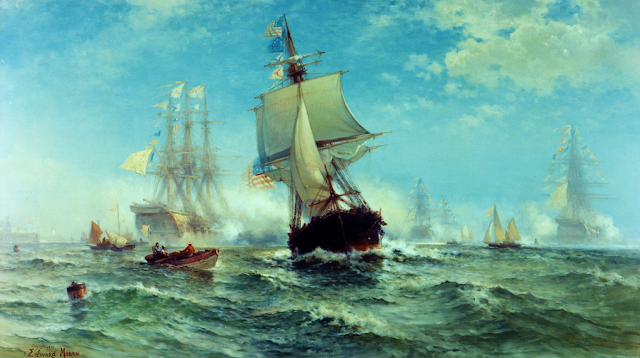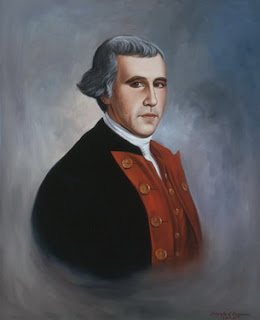A quick note: my name is Mike Romero, and I'm a Historic Interpreter at Colonial Williamsburg. The postings I make on this site are my own personal opinions and research, and do not necessarily reflect the views of Colonial Williamsburg. With that said, enjoy the read!
-=|Blog Home||Reading Room||Source List=-
On 1 November 1777, Captain John Paul Jones set out across the Atlantic in command of the 18-gun sloop-of-war Ranger. As Jones had recently written to the Marine Committee, "I have before me the pleasing prospect of being the welcom Messenger at Paris of the Joyful and important News of Burguoyne's Surrender &c &c. I have received dispatches from the Council of the Massachusetts for the Commissioners & Express. -I shall not therefore go out of my Course Unless I see a fair Opportunity of distressing the Enemy and of rendering Services to America."
Approximately halfway across the Atlantic, Ranger nearly rolls over in the aftermath of a heavy gale; her tiller rope parted and she very nearly broached to, rolled nearly onto her beam ends. Fortunately, Ranger righted herself, having confirmed Jones's initial opinion that she was over-sparred and top heavy...he would never stop tinkering with Ranger's rigging and trim during his time in command.
The remainder of the passage goes smoothly until Ranger is approaching Land's End off the British Isles. A lookout sights seventeen sail, and Jones promptly orders his crew to give chase. It isn't long before the crew discovers this is a homeward bound merchant convoy, escorted by the 74-gun ship-of-the-line HMS Invincible. Ranger's crew, once eager for prize money, now finds themselves terrified for their lives. In no circumstance could an 18-gun sloop-of-war expect to engage an enemy 74. Fortunately, though, Jones keeps his cool. As one of Ranger's crew later writes, "Our Captain took a very wise Step, which was, to heave to with the Convoy, and there lay with our Prizes, 'till the Commodore of the Fleet made Sail, which was in about two Hours; we then made Sail with the Convoy and tarried with them until almost Night, and then tackt Ship to the Southward, and got clear." Invincible was apparently none the wiser at having escorted a rebel cruiser for several hours. While Jones was disappointed at not having the chance to take any merchantmen from the convoy, he apparently used the episode as an excuse to exercise his men in night operations.
Ranger arrives at the port of Nantes, France on 2 December 1778, apparently one day after another American vessel had arrived and spread word of the victory at Saratoga. Upon arrival in France, Jones expected to be granted command of the frigate Indien, recently built in Amsterdam. Unfortunately, British officials learned of the intended sale of the vessel, and pressured the Dutch to back out of the deal and maintain their neutrality; Indien is sold to the French, but several years later ends up in American service as the South Carolina. In late December, Jones travels to the suburbs of Paris to meet with American commissioners and share his ideas for the next year of the war, from planned raids along the British coast to prisoner exchanges.
On 16 January 1778, Jones is issued orders to cruise with Ranger "in the manner you shall judge best, for distressing the Enemies of the United States, by Sea or otherwise, consistent with the Laws of War, and the Terms of your Commission." Given Jones's plans to raid British ports and coastal towns, the American commissioners warn him not to return directly to France after such expeditions, so as not to damage their neutrality. (The alliance between France and the United States had yet to be formalized at this point.) He spends the next few weeks adjusting Ranger's masts, rigging, and trim, and taking her on several problematic shakedown cruises in Quiberon Bay.
While on one such cruise on 14 February, Jones fires thirteen guns in salute of a French warship, and receives nine in return. Jones proudly reports "this was the first salute received by the American flag from any sovereign power." This applies only to the Stars and Stripes, officially adopted by the Continental Congress in June of 1777. The Grand Union Flag, while never officially adopted, had received its first salute aboard the brig Andrew Doria from the Dutch in November of 1776.
The summer of 1778 would be an active season for the crew of Ranger, at least one attempted mutiny notwithstanding. Jones would lead a raid on the port of Whitehaven on 23 April, when his two lieutenants claimed to be "too fatigued to perform their duties." The raid did little actual damage beyond the harbor guns being spiked and several ships being set afire, but it alarmed British citizens up and down the coast that the American Revolution had come to their very doorstep. The following day, Ranger would defeat the sloop-of-war HMS Drake near Carrickfergus in Ireland. Avaricious sailors from Ranger would plunder the Earl of Selkirk's family silver when the nobleman himself proved so inconsiderate as to not be home so he might be abducted. These actions, along with numerous merchant captures by Jones and crew during 1778 and 1779 would cause insurance rates to skyrocket, and cement Jones's reputation as a pirate among the British populace. (One engraving would represent John Paul Jones as a reincarnation of Blackbeard himself.) These are, of course, stories for another day.
Sources:
1. Crawford, Michael, ed. Naval Documents of the American Revolution, Volumes 10 and 11. (Washington: Naval Historical Center, 1996 and 2005.)
2. Thomas, Evan. John Paul Jones: Sailor, Hero, Father of the American Navy. (New York: Simon & Schuster, 2003.)
 |
| John Paul Jones circa 1781 by Charles Wilson Peale. |
Approximately halfway across the Atlantic, Ranger nearly rolls over in the aftermath of a heavy gale; her tiller rope parted and she very nearly broached to, rolled nearly onto her beam ends. Fortunately, Ranger righted herself, having confirmed Jones's initial opinion that she was over-sparred and top heavy...he would never stop tinkering with Ranger's rigging and trim during his time in command.
The remainder of the passage goes smoothly until Ranger is approaching Land's End off the British Isles. A lookout sights seventeen sail, and Jones promptly orders his crew to give chase. It isn't long before the crew discovers this is a homeward bound merchant convoy, escorted by the 74-gun ship-of-the-line HMS Invincible. Ranger's crew, once eager for prize money, now finds themselves terrified for their lives. In no circumstance could an 18-gun sloop-of-war expect to engage an enemy 74. Fortunately, though, Jones keeps his cool. As one of Ranger's crew later writes, "Our Captain took a very wise Step, which was, to heave to with the Convoy, and there lay with our Prizes, 'till the Commodore of the Fleet made Sail, which was in about two Hours; we then made Sail with the Convoy and tarried with them until almost Night, and then tackt Ship to the Southward, and got clear." Invincible was apparently none the wiser at having escorted a rebel cruiser for several hours. While Jones was disappointed at not having the chance to take any merchantmen from the convoy, he apparently used the episode as an excuse to exercise his men in night operations.
Ranger arrives at the port of Nantes, France on 2 December 1778, apparently one day after another American vessel had arrived and spread word of the victory at Saratoga. Upon arrival in France, Jones expected to be granted command of the frigate Indien, recently built in Amsterdam. Unfortunately, British officials learned of the intended sale of the vessel, and pressured the Dutch to back out of the deal and maintain their neutrality; Indien is sold to the French, but several years later ends up in American service as the South Carolina. In late December, Jones travels to the suburbs of Paris to meet with American commissioners and share his ideas for the next year of the war, from planned raids along the British coast to prisoner exchanges.
 |
| "First Recognition of the American Flag by a Foreign Government." Painting by Edward Moran circa 1898. |
On 16 January 1778, Jones is issued orders to cruise with Ranger "in the manner you shall judge best, for distressing the Enemies of the United States, by Sea or otherwise, consistent with the Laws of War, and the Terms of your Commission." Given Jones's plans to raid British ports and coastal towns, the American commissioners warn him not to return directly to France after such expeditions, so as not to damage their neutrality. (The alliance between France and the United States had yet to be formalized at this point.) He spends the next few weeks adjusting Ranger's masts, rigging, and trim, and taking her on several problematic shakedown cruises in Quiberon Bay.
While on one such cruise on 14 February, Jones fires thirteen guns in salute of a French warship, and receives nine in return. Jones proudly reports "this was the first salute received by the American flag from any sovereign power." This applies only to the Stars and Stripes, officially adopted by the Continental Congress in June of 1777. The Grand Union Flag, while never officially adopted, had received its first salute aboard the brig Andrew Doria from the Dutch in November of 1776.
 |
| A Whitehaven statue depicting Jones spiking the guns in April 1778. |
Sources:
1. Crawford, Michael, ed. Naval Documents of the American Revolution, Volumes 10 and 11. (Washington: Naval Historical Center, 1996 and 2005.)
2. Thomas, Evan. John Paul Jones: Sailor, Hero, Father of the American Navy. (New York: Simon & Schuster, 2003.)















